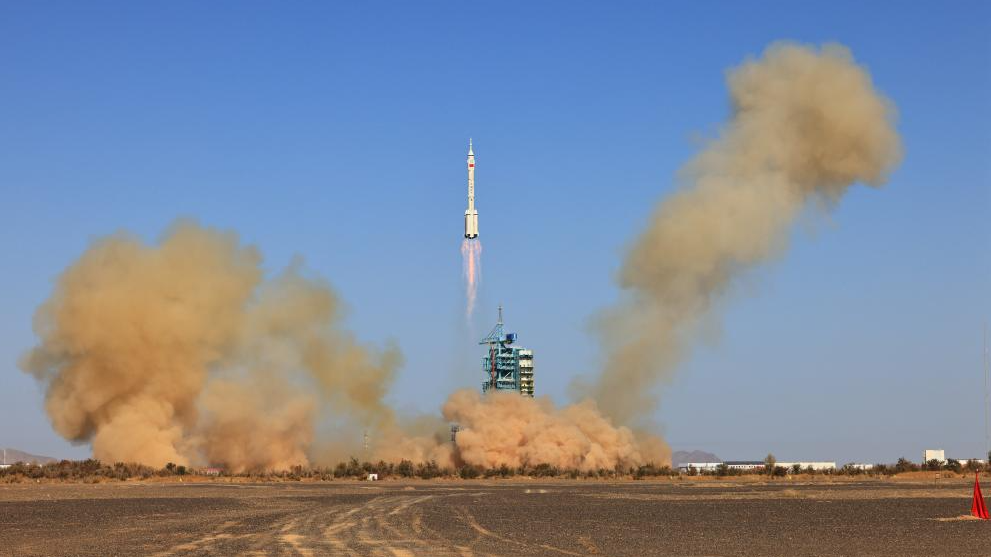
The Shenzhou-17 manned spaceship, atop a Long March-2F carrier rocket, blasts off from the Jiuquan Satellite Launch Center in northwest China, October 26, 2023. /Xinhua
The Shenzhou-17 manned spaceship, atop a Long March-2F carrier rocket, blasts off from the Jiuquan Satellite Launch Center in northwest China, October 26, 2023. /Xinhua
Editor's note: Yang Yuguang, a special commentator of CGTN, is vice chair of the IAF (International Astronautical Federation) Space Transportation Committee. The article reflects the author's opinions and not necessarily the views of CGTN.
With the successful launch of Shenzhou-17 spaceship on October 26, the China space station project started its second manned mission during the phase of application and development. Although the technical specifications of Shenzhou-17 are very similar to Shenzhou-16, it still has its distinctive features. It will be a very important mission for China to master the necessary technologies for repairing the station.
Operating a space station for more than 10 years is not an easy task. Across history, only Russia's Mir space station and the International Space Station operated for more than 10 years. On the other hand, the above two space stations worked much longer than their designed lifespan, which brings great benefit and enormous scientific returns to Russia and the U.S. Thus, we hope that China's Tiangong space station can also operate much longer than 10 years.
But as time goes by, malfunction will be more frequently seen in parts, subsystems, and modules of a space station. According to Lin Xiqiang, deputy director of the China Manned Space Agency, the space station's solar wings have been hit by tiny space particles several times, causing minor damage. Although it hasn't caused any serious problems now, it is the right moment for China to test corresponding technologies for repairing the Tiangong space station.
Repairing and maintenance tasks include those inside the pressured modules and those outside these modules. The latter can only be accomplished by extravehicular activities (EVAs). Compared with EVAs during the construction phase and those for scientific research, the most distinctive feature of repairing is the high uncertainty astronauts must face. Astronauts not only need to see the phenomena of what happened but also have to find the reason causing these malfunctions during EVAs. There could be all kinds of reasons causing the malfunction, which can hardly be predicted. Therefore simulation and ground training can hardly cover all possibilities. That is the reason why EVAs in repairing tasks are more challenging for astronauts.
Although this will be a very difficult task, we believe the Shenzhou-17 crew can accomplish it. We should remember that Tang Hongbo, commander of Shenzhou-17, is also a crew member of Shenzhou-12, which is the first manned mission to China's Tiangong space station.
During the Shenzhou-12 mission, China's space station program was still in the technology demonstration and verification phase. At that moment, China had already mastered the three fundamental technologies of manned space flight, i.e., crew transportation technology, rendezvous and docking technology, and EVA technology. But that does not mean China has mastered all critical technologies to operate an advanced space station.

Chinese astronauts Tang Hongbo (C), Tang Shengjie (R) and Jiang Xinlin who will carry out the Shenzhou-17 spaceflight mission. /Xinhua
Chinese astronauts Tang Hongbo (C), Tang Shengjie (R) and Jiang Xinlin who will carry out the Shenzhou-17 spaceflight mission. /Xinhua
One of the important technologies to be verified is the second-generation Feitian EVA spacesuits. Tang Hongbo and his companion, Liu Boming conducted the first EVA of the Tiangong space station. In 2021, both of them wore the second generation Feitian spacesuits and stayed outside the station for seven hours. This EVA provided a very valuable experience to Tang Hongbo. We believe he can also accomplish the coming EVAs during the Shenzhou-17 mission.
Another important factor for China to operate the Tiangong space station normally is the regenerative environmental control and life support system. This system is much more complex than non-regenerative ones, which were used in Shenzhou spaceships and Tiangong-1 and Tiangong-2 space laboratories. But mastering technologies of regenerative environmental control and life support system is an essential requirement for China to operate its own space station, otherwise, there will be too many resources wasted in providing water, oxygen and other resupplies to astronauts. The major purpose of constructing the Tiangong space station is to conduct all kinds of scientific research; we should reduce the amount of resupplies demanded to the lowest level. During the Shenzhou-12 mission, Tang Hongbo and his two colleagues tested the oxygen production system, water recovery system, urine processing system, hazardous gas removal system, carbon dioxide removal system, and carbon dioxide recovery system. These six subsystems form the regenerative system and the three-month operation of these systems during the Shenzhou-12 mission gave us extremely important experience and knowledge on how it works. In this process, Tang Hongbo played an important role in accomplishing this task.
For the coming Shenzhou-17 mission, because Tang is already familiar with the regenerative environmental control and life support system, and the corresponding system in the Wentian laboratory module has the same specification and design as that in the Tianhe-1 core module, he can ensure the normal operation of this important system during the six-month stay in Tiangong space station. He also has the experience on how to fix it.
Besides the intensive and wide range of scientific research tasks, ensuring the normal operation of the space station is also not easy. Tang Shengjie and Jiang Xinlin, the two young companions of Tang Hongbo, will also become veterans after this Shenzhou-17 mission, and have plenty of chances to join future manned missions. Their experience in operating the station will also be helpful in future station missions. Tang Hongbo is the first one to reenter the Tiangong space station, but absolutely, he will not be the last one.
(If you want to contribute and have specific expertise, please contact us at opinions@cgtn.com. Follow @thouse_opinions on Twitter to discover the latest commentaries in the CGTN Opinion Section.)